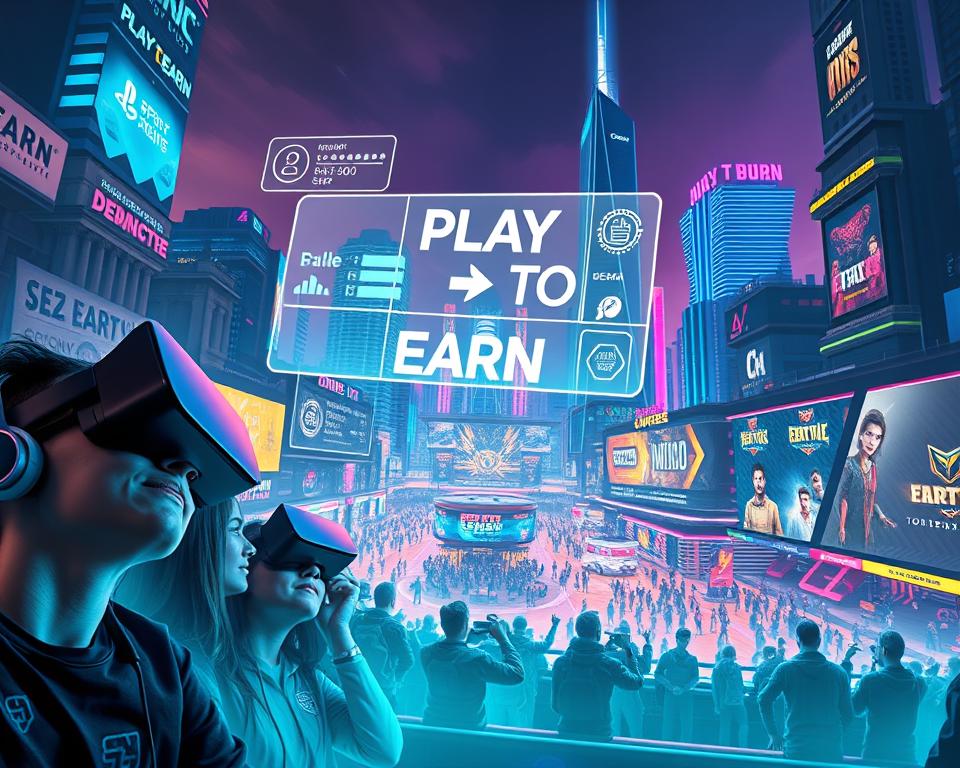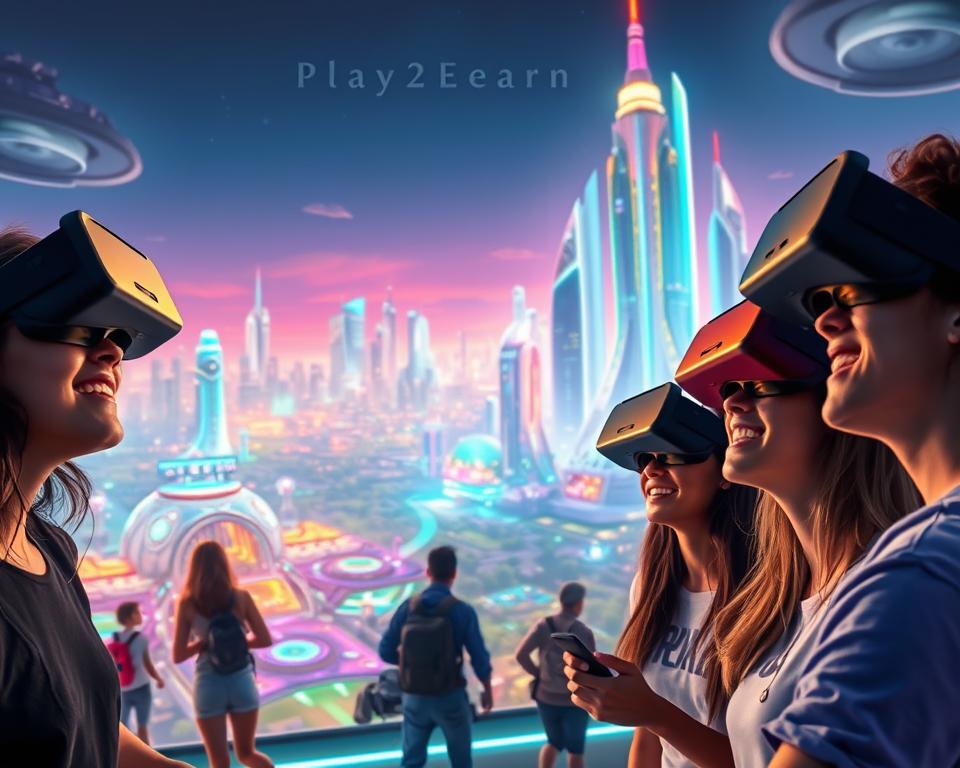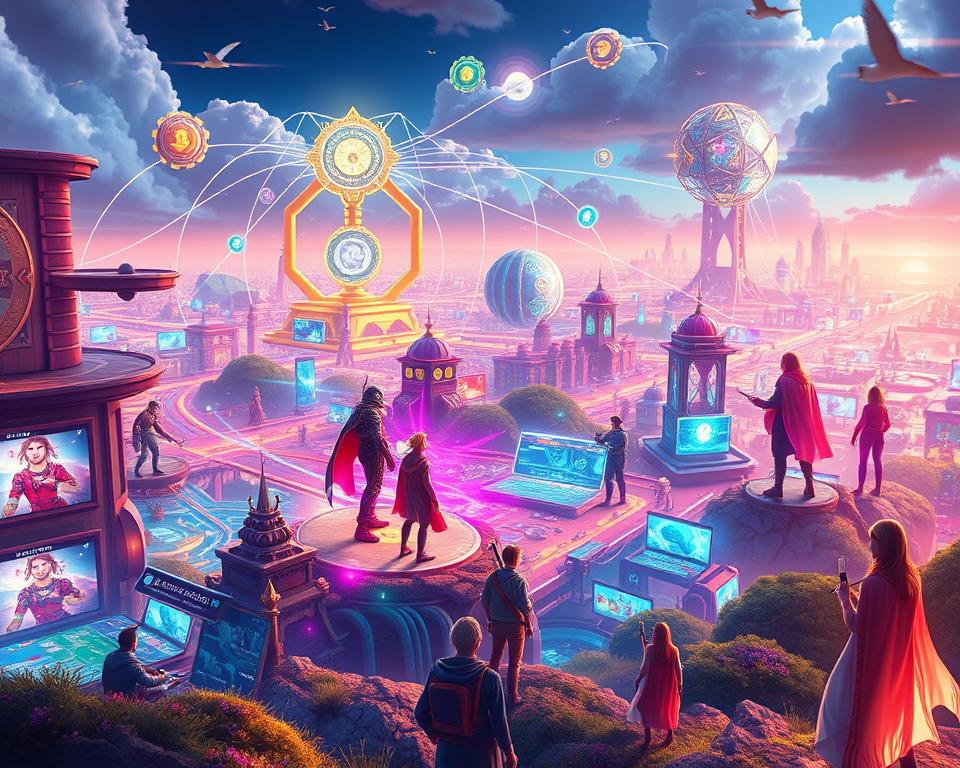Anúncios
Can the games industry really deliver real value and true ownership without sacrificing the fun you expect? This question matters now that gaming tops movies, TV, and music in revenue. It also matters because millions of players in the United States and worldwide care about how items, rewards, and economies work in a game.
In this short guide, you’ll get a clear map of the persistent claims and the facts behind them. We’ll explain how traditional item markets — like CS:GO skins — already shape value and ownership. Then we’ll show where blockchain fits without taking over the fun.
Expect focused, practical sections that separate hype from reality. You will learn why developers and companies are changing models, what that shift means for your gaming experience, and how players’ interests can align with healthy development.
Read with caution, check reliable sources, and treat this as a starting point for smart, responsible exploration of the market and the future of games.
Introduction: play to earn myths you still hear in 2025
play to earn myths still shape many conversations about games in 2025, often because people mix gaming culture with headline-driven finance talk.
You should care because your time and attention have value. Knowing how ownership and marketplaces work helps you pick better experiences. Developers now balance traditional gaming design with new models so the game itself stays fun and fair.
Why this matters for your gaming experience
Onboarding used to demand seed phrases and awkward steps. That friction kept many players away.
Today, tools like Immutable Passport (1.5M signups) and platform support show a clear shift. Almost $20B poured into web3 gaming over recent years has driven smoother flows and clearer choices.
How blockchain technology fits without stealing the show
Example: Guild of Guardians launched on mobile and hit a 4.9/5 rating with 30K downloads in two days. That shows a mobile-first design can cut time to start and remove barriers for gamers.
Bottom line: blockchain and related technology can work behind the scenes to support ownership and marketplaces while the game remains the main attraction. The sections that follow give facts, examples, and tips so you can judge any title on its merits.
Before the myths: what “play-to-earn” really means in blockchain games
Your first check: does an item belong only to a game account, or can it move and hold market value outside the title?
From in-game value to real-world value: lessons from CS:GO and Valorant
Look at CS:GO: skins trade on open marketplaces and sometimes sell for tens of thousands. That market creates price discovery and real-world value driven by player demand.
By contrast, Valorant locks items to accounts and bans third-party trading. That closed system caps resale and keeps value inside the game.
Ownership of digital assets vs. access in traditional gaming
Ownership means you can hold, transfer, or sell an asset outside the original platform. Access means the item stays bound to your account and can disappear if policies change.
Quick practical test: if you stop playing, can you transfer the item or recover some value? If not, it’s access, not true ownership.
- Models vary: cosmetics, progression items, or hybrid economies affect outcomes.
- Open transactions enable price discovery but add fees and scam risks.
- Your time, skill, and community demand can help an asset gain value, but nothing is guaranteed.
Tip: evaluate a game’s economy rules like you would check updates or matchmaking—those rules shape value more than the technology itself.
Myth: Play-to-earn is just pay-to-win scams
Some gamers fear that buying items will replace mastering mechanics. That concern matters. When spending bypasses gameplay, matches feel unfair and value drifts from skill to wallets.
Reality: skill, strategy, and time create real value
Example: Gods Unchained rewards daily effort with card packs and lets players trade NFT cards. Immutable reports sustained monthly transactions near $130 per player and more daily engagement than many top mobile games. That shows a nft game can reward skill and strategy without forcing purchases.
Design matters: separating markets from core loops
Good developers keep the core game independent from the market. That means you compete on skill and deck building, not who spends more.
Quick checklist for fair models
- Clear token sinks and caps on inflation
- Transparent drop rates and reasonable fees
- Rank brackets, solid matchmaking, and tournament formats
Tip: read patch notes, watch early matches, and judge the gameplay yourself. Community feedback often flags when models tilt away from fun-first design.
Myth: You need to be crypto-savvy to start
Getting started isn’t as technical as headlines make it sound. Modern onboarding hides much of the complex work so you can focus on the game and the experience.
Friction is dropping: app store onboarding and embedded wallets
Many games now use embedded wallets or custodial accounts that feel like normal app sign‑ins. You can register with email or social login and skip seed phrases at first.
Example: Immutable Passport has 1.5M signups and lets players sign in with familiar flows. That reduces setup time and helps you get into matches faster.
Real example: Guild of Guardians’ mobile launch metrics
Guild of Guardians hit a 4.9/5 rating and 30K downloads in two days. Many players started without touching blockchain details.
Take control at your pace: try free modes, test performance, then explore ownership features later. Moving to self-custody is optional and should be done carefully.
- Review account recovery and support before spending.
- Start with in‑game trials to learn gameplay and network impact.
- Use convenience tools first, then consider full custody if it fits your needs.
Myth: There’s no real ownership of digital assets
Let’s clear up what real ownership of a digital asset looks like in simple terms. Real ownership means a record shows an item belongs to your wallet, not just a license inside one account.
Fact check: verifiable ownership via blockchain ledgers
Blockchains act as public ledgers. That ledger records which wallet holds an NFT and shows transaction history. Anyone can verify authenticity and provenance on-chain.
Control and portability: trading, selling, and cross-platform potential
You can move assets between wallets or list them on approved marketplaces, subject to each game’s rules.
- Transfer: send an NFT from your wallet to another you control.
- Marketplace: list items, noting fees and withdrawal steps.
- Portability: cross‑platform use depends on developer support and standards.
- Transparency: public transactions help reduce some fraud types.
Analog example: trading card games to NFT game economies
Think of Pokémon or Magic cards: you own the physical card and can trade or sell it. NFT card titles like Gods Unchained and Splinterlands mirror that model online.
Important: value depends on player demand, supply, and game health. Ownership gives you options, not guaranteed outcomes. Verify contract addresses, read fees, and check development roadmaps before major moves.
Myth: Web3 and blockchain games have poor graphics and basic gameplay
Modern game engines let developers build rich worlds and refined gameplay for blockchain projects. Unreal Engine and Unity now support web3 integrations, which brings industry-grade pipelines for lighting, effects, and netcode into this space.

- Space Nation Online — a AAA web3 MMORPG that targets large-scale world building and social systems beyond simple loops.
- The Red One — an Unreal Engine 5 extraction shooter showcasing advanced lighting, materials, and performance goals.
- Medieval Empires — strategy visuals that balance readability with fine detail and thoughtful UI features.
Design goals shape visuals. You’ll find a wide range of styles: pixel art, stylized, and near-photoreal. High fidelity is possible, but it isn’t the only path.
Graphics don’t guarantee fun. Gameplay depth, balance, and systems design still decide long-term replay value. Watch trailers, try playtests, and compare builds on your hardware.
Practical tip: expect iterative improvement. Post-launch patches often improve effects, LODs, and controller feel. Read tech notes and judge each game by its visible features and performance rather than labels.
Myth: AAA studios and major publishers ignore blockchain games
Major studios are watching experiments closely, not walking away from them. You’ll find concrete signals across the industry rather than blanket abandonment. That matters if you follow games and value long-term development trends.
Industry signals: investments and pilots
Twenty-nine of the world’s 40 largest gaming companies, including Sony, Ubisoft, and Epic Games, have active investments or pilots in blockchain games. Sony has patents for cross‑platform digital assets, Ubisoft has run pilot projects, and Epic accepts blockchain titles on its store.
Funding and market forecasts
Funding examples are concrete: CCP Games raised $40M for an AAA blockchain project. Netmarble migrated MARBLEX and three hit titles to Immutable; those titles generated over $80M revenue in 2024.
- Market forecast: analysts project growth from about $4.6B in 2022 to $65.7B by 2027,
- Why developers explore this: verified ownership, lower platform fees in some cases, and new player-driven value models,
- Regional and platform note: experiments vary—some focus on PC, others on mobile—so timelines differ.
Bottom line: investment and pilots show serious industry interest, but that doesn’t mean universal adoption. Evaluate each company announcement on its merits and watch how execution affects players and game value.
Myth: The market is tiny and will fade fast
Concrete usage numbers give a clearer picture than headlines or short-term buzz. Immutable’s zkEVM reports nearly 2 million monthly active users. Netmarble titles that moved platforms show over 1 million MAU and generated $80M in 2024.
These figures show active engagement, not guaranteed growth. Adoption is uneven by game and platform. Still, the data signals a base audience and real-world value drivers.
Adoption signals: millions of monthly active users
Numbers matter. High MAU counts prove players are using wallets and marketplaces at scale. That creates feedback loops for developers and communities.
Wide range of genres and models
Genres now include MMORPGs, shooters, strategy, and TCGs. A wide range of design experiments means models are diversifying beyond early tests.
- Growth is uneven; some titles spike and fade.
- Durable value needs stable retention and fair economies over years.
- Watch patch cadence, roadmap delivery, and player reviews for signals.
Takeaway: the market is not tiny, but long-term value depends on good game design, honest communication, and steady development.
Myth: NFT games operate in a legal gray area
Legal uncertainty is a worry, but the fact is many studios treat compliance as part of design. Reputable game development companies build terms, IP rules, and consumer protections before launch. That reduces surprises for you as a player.
Compliance in practice: IP, consumer protection, and transparency
Clear terms matter. Good companies spell out ownership, transfer limits, refund rules, and how transactions work. Read those pages so you know your rights for digital assets.
On-chain records help with audit trails, but privacy and dispute processes still rely on company policies.
- Many companies follow IP and consumer rules and run legal reviews during development.
- Some titles add KYC/AML for cash-out flows where local law requires it.
- Policies differ by country and platform; one market may allow a feature another restricts.
Practical steps: save receipts, verify contract addresses, and review marketplace and support pages before trading.
This is not legal advice—check official policies and local regulations before you transact.
What traditional gaming teaches us about value, ownership, and marketplaces
Simple rules shape how items gain worth. Look at two clear examples and what they mean for you as a player.
Closed economies vs. open marketplaces
Valorant keeps items tied to accounts and blocks third‑party trading. That reduces fraud and simplifies support, but it limits resale and liquidity.
CS:GO lets items appear on open markets. That creates price discovery and can multiply in‑game item value through free transactions. It also adds complexity and fees that both developers and players must manage.
Design takeaway: how developers and players both benefit
Developers gain ongoing primary and secondary activity with open markets. Players gain choice, liquidity, and a path to recover some value.
- Trade-offs: closed systems cut fraud; open systems need clear policies and posted fees.
- Checklist for evaluation: transferability, fee structure, support response times, rarity tables.
- Practical path: try free matches, then test low‑cost items before larger moves.
When developers and players agree on clear rules, both sides enjoy a healthier ecosystem.
Conclusion
Conclusion
What matters most is whether a game delivers a strong experience, then adds optional economic features responsibly.
Today’s signals are clear: easier onboarding (like Immutable Passport signups), major publishers testing ideas, and varied genres from TCGs to MMORPGs and shooters experimenting with ownership digital assets and markets.
Remember the facts: myths persist, but many titles mix familiar fun with new options that can add real value for players.
Move at your pace. Start with gameplay, check terms, fees, and rarity tables, and consult trusted sources before any investment.
Final tip: compare several games, watch patch notes, and follow official channels. Explore responsibly, enjoy the gaming, and stay informed as the future unfolds.



